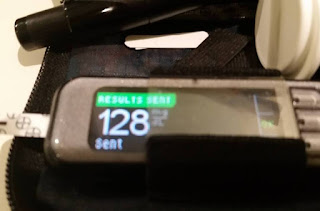It's hard to imagine life before bolus wizard, isn't it? Before bolus wizards, before insulin pumps, before Lanuts and Trujeo, and Apidra there was NPH, Regular, Ultra Lente. Diabetes management consisted of an exchange diet and a sliding scale for insulin. The exchange diet was basically an allotment from the food pyramid per meal: for breakfast you might get 1 milk, 2 starch, 1 fat, and 1 fruit. The sliding scale for insulin delivery consisted of something along the lines of: if your blood sugar was between 80-120 you'd take 4 units of short acting insulin and 10 units of long acting. And that in a nutshell was diabetes management in the 1980s. (and way before that was urine testing and a shot of mixed beef/pork insulin).
Fast forward a bit to 2000 when I decided to pursue insulin pump therapy, for more flexibility with managing my disease. In 2000 there were two companies in this space. Medtronic Diabetes, and Disetronic Medical Systems. I chose Medtronic Diabetes because I was aware of the company, and their history, and felt it was the right option for me. Before starting on the pump, as a patient at the Joslin Diabetes Center in Boston I had to meet with a social worker and diabetes educator to ensure I was going on a pump for the right reason. To them "I want to go on a pump so I can eat donuts all day" wasn't a good reason, but wanting more flexibility in my life was.
Between 2000 and today I have used several MiniMed pumps. Each new pump included the addition of more innovate technology than the previous:
- 2000: MiniMed 508 This pump came out in 1999 and I started on it in the spring of 2000. It featured bolus and basal, and a temporary basal option, and came with a remote control to deliver a bolus!
- This pump operated on 3 watch size batteries, which made me a frequent customer at Radio Shack.

- 2004: Paradigm 512: This pump came to market in 2003, and my best guess is I started on it sometime in 2004. This pump introduced us to bolus wizard, and the blood glucose meter transmitting readings directly to the pump.
- Bolus wizard calculates the amount of insulin a person should take based on input from the insulin pump user including active insulin, blood glucose level, and number of carbohydrates in a given meal.
- I use this feature daily - to determine if a correction is needed for high blood sugar, and to help figure out insulin dosing for food.

- 2011: Revel: This pump came to market around 2010/2011, and I most likely started using it around that same time. The Revel introduced us to the continuous glucose monitor (CGM), and SofSensor.
- I was an early adopter of this pump due to the continuous glucose monitor.
- The SofSensor worked well for me, but I was a chicken when it came to the insertion process and insurance didn't cover CGM back then so I didn't use it frequently.

- 2014: 530G with Enlite This system was approved by the FDA in 2013 and I started on it in 2014. This system introduced the Enlite sensor and threshold suspend, and an easier CGM sensor insertion process.
- Threshold suspend (also known as Smart Guard) was a turning point for me with my diabetes management.
- As a person with a history of overnight low blood sugar, the idea of the pump stopping delivering insulin once the cgm readings reached a set low number (that I worked on with my doctor), was a game changer.
- The Enlite sensor/cgm system has worked great for me. My cgm readings and blood glucose readings are often within a few points from each other.

- 2016: 630G system with smart guard technology: This pump came to market in August 2016 and I have been using it since October. This system introduced us to a new platform, a vertical pump layout, waterproofing, and large color screen.
- I wasn't initially sure about this one. On paper it seemed like a shinier version of my beloved 530G. But, I'm glad I made the switch.
- Some of my favorite features:
- The screen which shows everything I need to know about my diabetes management at a glance.
- The Guardian transmitter: this transmitter has a stronger signal, and as such I haven't had any connection issues since starting the pump. With the 530G I received weak signal errors on a weekly basis.
- Alarms: The alarm chimes have changed, and there are more volume options which have been great.

